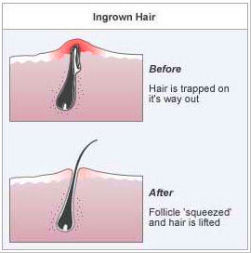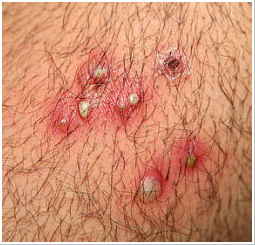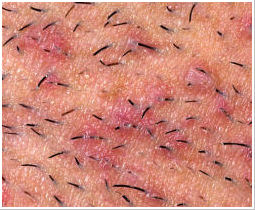If you have or ever had ingrown pubic hair then you do not have to be told how much of a pain in the neck it can be. On the list of Top Ten worst things in life it may not make the list but it is an annoyance regardless.
The ingrown hairs are itch, irritate and can be unsightly. For some they become inflamed, turning into red bumps or even pustules, causing both embarrassment and discomfort.
Generally those with curly, coarse hair suffer most from an ongoing problem with ingrown hairs, but everyone who waxes, tweezes or shaves will be faced with them at some time.
What Causes Razor Bumps or Ingrown Hairs?
 They usually appear in areas where you frequently shave, for example a woman’s legs, bikini or underarm area and a man’s face.
They usually appear in areas where you frequently shave, for example a woman’s legs, bikini or underarm area and a man’s face.
They occur when you remove, cut or break hair below the skin’s surface, when the hair curls back on itself and grows back into the follicle, or when it remains within the follicle.
Often you can see the hair under the skin, where it may resemble a blackhead. If you pluck it, the uncoiled hair can be surprisingly long.
Get Rid of Them by Freeing Them
Your aim is to uncurl the tip allowing the hair to continue growing above the surface of your skin without actually removing the hair.
To do this, gently exfoliate the area daily, removing the dead skin which blocks the hair from escaping. Vary the direction of your brushing which should be vigorous enough to expose the hair without drawing blood.
Should you ever catch sight of a loop of hair peeking out, it is one which has curled back into the hair follicle. Thread a needle or similar sharp instrument into the curl and gently pull until the one end of the hair is freed.
Despite the hair being visible, it’s sometimes quite deep. If you’re like me, it’s overly tempting to gouge them out. My ingrown hairs are on the outside of my upper calf, so although I’m sometimes left with nicks, they haven’t left noticeable marks. (Or possibly I haven’t looked with my specs on!)
The correct procedure if an ingrown hair stubbornly remains buried, is to soak a face-cloth in hot water. Wring it out before placing it over the area to soften the skin.
Dip tweezers in peroxide, boiling water, iodine or rubbing alcohol to sterilize them and prevent infection, then gently pluck the hair. You’ll find pointed tweezers, instead of flat-tipped ones, result in practically no damage to your surrounding skin. Or try using a needle to fish out ingrown hairs.
The experts suggest you only free the hair by lifting out the tip from the follicle without plucking it from the root.
Finish off by dabbing with an antiseptic like witch hazel in order to prevent infection, reduce swelling and redness.
 Infected Ingrown Hair
Infected Ingrown Hair
Those suffering from full-on folliculitis when the hair follicle becomes infected will experience red bumps or white pustules which later crust over. If this is you, where possible, give your follicles a chance to recover by taking a break from hair removal.
Keep the area sterile and pat on salicylic acid or benzoyl peroxide (acne medication) to the pustules two or three times a day for two or three days.
Twice daily, after soaking a face-cloth in scalding hot tap-water, cover the infected area until the cloth cools down. Both the skin and the hair beneath your skin will soften, helping it rise to the surface, drawing out pus and reducing inflammation.
Resist the temptation to squeeze the pustule. Rather persist with applying warm compresses, keeping the area clean and well moisturized until it has healed.
If you’re overcome with the urge to extract the hair, do so by gently squeezing its sides. If that doesn’t work, using tweezers or a sterile needle, gingerly tease out the trapped hair, without tearing the skin or digging for it.
If your efforts prove fruitless, be patient; possibly the hair is too short to be extracted, in which case continue re-applying hot compresses until it does appear.
When trying to get rid of them, prevent infection by swabbing the area twice daily with hydrogen peroxide. Should pus ooze out, wipe it clean and dab with the hydrogen peroxide. In the event the area is conducive to chafing, cover with some gauze and a band-aid.
In the case of deep ingrown hairs, after the twice daily hot compresses, apply an antiseptic cream in order to keep the area moist.
In those instances where this doesn’t work, if it becomes too painful or it lasts for longer than a couple of days, speak to a dermatologist who may prescribe antibiotics.
Prevent or Drastically Reduce Ingrown Hairs From Occurring

- Keep your skin moist and soft
Excessively dry skin encourages ingrown hairs. Use a non-comedeogenic shaving cream, cleanser and moisturizer containing salicylic or glycolic acid (an alpha hydroxy or fruit acid) with a 10% concentration minimum, on any area prone to ingrown hairs. Non-comedeogenic products don’t clog pores and help the skin stay clean, soft and pliable.
- Exfoliate
The most popular removal method anywhere on your body is to gently scrub the ingrown hair area daily to remove dead skin cells, dirt and oils blocking the pores and trapping the hair.
Exfoliating pads, loofahs, synthetic sponges, shaving brushes and mild scrubs all work well. Or use a body scrub together with a loofah.
Before you Remove hair
No matter how you remove your hair, start by soaking a cloth in very hot tap water. Spread the hot wet cloth on your skin for a few minutes until the cloth cools, softening both the hair and skin, opening the pores allowing the hairs to stand up straighter and taller.
Or remove hair after soaking in a long hot bath which has a similar effect.
Trim pubic hair with scissors before shaving; it makes your life a lot easier.
Use shaving cream to soften the hair and protect the skin.
Get Rid of Them by Practicing Proper Shaving Technique
Shaving results in a sharp end which easily pierces back into the hair follicle if the hair curls beneath the skin.
- Longer hair is less likely to curl back into the skin so shave less closely by using a single blade razor – multi-bladed razors cut the hair too close.
- Instead of shaving every 24 hours, shave every 2 to 3 days.
- If prone to ingrown hairs, use the razor only once or twice and discard before it becomes blunt. Or even better, use an electric razor.
- Shave with the grain of the hair, in the direction of the hair growth.
- Don’t stretch the skin, otherwise you get too close a shave.
- Avoid too much pressure on the skin while shaving.
- Don’t shave the same area over and over again trying to get a closer shave.
All these rules keep the tip of the hair at or above skin level. So although your shave might not be as close as you would like it, at least you won’t be suffering from ingrown hairs.
After shaving, splash cold water over the area to close your pores and use a moisturizing aftershave balm containing witch hazel, azulene or allantoin to keep the skin and hair soft.
Post-shaving creams and lotions prevent infection, inflammation, redness and swelling. But steer clear of products containing alcohol since they dry out the skin and worsen irritations.
Consider Changing Your Hair Removal Method
Shaving is less irritating to the follicle than waxing. Waxing removes the hair from below the surface of the skin and is more likely to result in the condition because hairs are either removed or break off below the skin line.
If you wax and suffer from ingrown hairs, try depilatory creams. They result in a smoother, more rounded tip than shaving, tweezing or waxing. If depilatories irritate your skin or sinus, try shaving with an electric shaver.
In fact, try all the different hair removal methods and see which works best for you.
Also consider letting the hair grow while you exfoliate and moisturize. Although not always practical, it gives the skin a chance to improve and sometimes lessens the likelihood of ingrown hairs in the future.
Wear Loose Clothing
After a fresh shave or bikini wax, prevent ingrown pubic hair by wearing loose clothing which doesn’t chafe or trap the hair against your skin.
If underwear leaves creases on your skin, replace synthetic with breathable cotton and wear a bigger size.
Tight jeans may also irritate ingrown hairs.
An Antiseptic
If you regularly experience this condition, apply an antiseptic toner or astringent after each shave or wax. This removes bacteria and prevents future pimples and ingrown hairs.
Natural Remedies and Products
Pat on tea tree oil after shaving. A few drops mixed with a carrier lotion like aloe, makes a good alternative to commercial shaving lotions.
Witch hazel, another natural antiseptic, when used after shaving prevents bacteria from growing in your newly opened pores and hair follicles.
Kalo is an all natural ingrown hair treatment solution. Quite expensive, but it seems to work.
Some products are strong and could irritate your skin so follow directions.
Permanent Hair Removal
If these tips fail to get rid of ingrown hairs and you are plagued by recurring distressing bouts, permanently removing the hair by electrolysis or laser is an option. You would need a couple of treatments before hair growth is destroyed and it’s quite pricey, but it would solve your ingrown hair problems.

